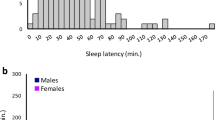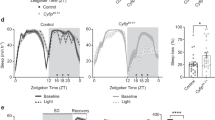Abstract
Most of us sleep 7–8 h per night, and if we are deprived of sleep our performance suffers greatly; however, a few do well with just 3–4 h of sleep—a trait that seems to run in families. Determining which genes underlie this phenotype could shed light on the mechanisms and functions of sleep. To do so, we performed mutagenesis in Drosophila melanogaster, because flies also sleep for many hours and, when sleep deprived, show sleep rebound and performance impairments. By screening 9,000 mutant lines, we found minisleep (mns), a line that sleeps for one-third of the wild-type amount. We show that mns flies perform normally in a number of tasks, have preserved sleep homeostasis, but are not impaired by sleep deprivation. We then show that mns flies carry a point mutation in a conserved domain of the Shaker gene. Moreover, after crossing out genetic modifiers accumulated over many generations, other Shaker alleles also become short sleepers and fail to complement the mns phenotype. Finally, we show that short-sleeping Shaker flies have a reduced lifespan. Shaker, which encodes a voltage-dependent potassium channel controlling membrane repolarization and transmitter release, may thus regulate sleep need or efficiency.
This is a preview of subscription content, access via your institution
Access options
Subscribe to this journal
Receive 51 print issues and online access
$199.00 per year
only $3.90 per issue
Buy this article
- Purchase on Springer Link
- Instant access to full article PDF
Prices may be subject to local taxes which are calculated during checkout




Similar content being viewed by others
References
Horne, J. A. Why we Sleep. The Functions of Sleep in Humans and Other Mammals (Oxford Univ. Press, Oxford, 1988)
Tobler, I. in Principles and Practice of Sleep Medicine (eds Kryger, M. H., Roth, T. & Dement, W. C.) 72–81 (W. B. Saunders, Philadelphia, 2000)
Rechtschaffen, A., Gilliland, M. A., Bergmann, B. M. & Winter, J. B. Physiological correlates of prolonged sleep deprivation in rats. Science 221, 182–184 (1983)
Shaw, P. J., Tononi, G., Greenspan, R. J. & Robinson, D. F. Stress response genes protect against lethal effects of sleep deprivation in Drosophila . Nature 417, 287–291 (2002)
Van Dongen, H. P., Maislin, G., Mullington, J. M. & Dinges, D. F. The cumulative cost of additional wakefulness: dose-response effects on neurobehavioral functions and sleep physiology from chronic sleep restriction and total sleep deprivation. Sleep 26, 117–126 (2003)
Borbely, A. A. & Achermann, P. Sleep homeostasis and models of sleep regulation. J. Biol. Rhythms 14, 557–568 (1999)
Dijk, D. J. & Lockley, S. W. Integration of human sleep-wake regulation and circadian rhythmicity. J. Appl. Physiol. 92, 852–862 (2002)
Stanewsky, R. Genetic analysis of the circadian system in Drosophila melanogaster and mammals. J. Neurobiol. 54, 111–147 (2003)
Lowrey, P. L. & Takahashi, J. S. Mammalian circadian biology: elucidating genome-wide levels of temporal organization. Annu. Rev. Genom. Hum. Genet. 5, 407–441 (2004)
Konopka, R. J. & Benzer, S. Clock mutants of Drosophila melanogaster . Proc. Natl Acad. Sci. USA 68, 2112–2116 (1971)
Bargiello, T. A., Jackson, F. R. & Young, M. W. Restoration of circadian behavioural rhythms by gene transfer in Drosophila . Nature 312, 752–754 (1984)
Zehring, W. A. et al. P-element transformation with period locus DNA restores rhythmicity to mutant, arrhythmic Drosophila melanogaster . Cell 39, 369–376 (1984)
Naylor, E. et al. The circadian clock mutation alters sleep homeostasis in the mouse. J. Neurosci. 20, 8138–8143 (2000)
Wisor, J. P. et al. A role for cryptochromes in sleep regulation. BMC Neurosci. 3, 20 (doi:10.1186/1471-2202-3-20) (2002)
Kopp, C., Albrecht, U., Zheng, B. & Tobler, I. Homeostatic sleep regulation is preserved in mPer1 and mPer2 mutant mice. Eur. J. Neurosci. 16, 1099–1106 (2002)
Shiromani, P. J. et al. Sleep rhythmicity and homeostasis in mice with targeted disruption of mPeriod genes. Am. J. Physiol. Regul. Integr. Comp. Physiol. 287, R47–R57 (2004)
Easton, A., Meerlo, P., Bergmann, B. & Turek, F. W. The suprachiasmatic nucleus regulates sleep timing and amount in mice. Sleep 27, 1307–1318 (2004)
Heath, A. C., Kendler, K. S., Eaves, L. J. & Martin, N. G. Evidence for genetic influences on sleep disturbance and sleep pattern in twins. Sleep 13, 318–335 (1990)
Linkowski, P. EEG sleep patterns in twins. J. Sleep Res. 8 (suppl. 1), 11–13 (1999)
Partinen, M., Kaprio, J., Koskenvuo, M., Putkonen, P. & Langinvainio, H. Genetic and environmental determination of human sleep. Sleep 6, 179–185 (1983)
Tafti, M. & Franken, P. Invited review: genetic dissection of sleep. J. Appl. Physiol. 92, 1339–1347 (2002)
Meddis, R., Pearson, A. J. & Langford, G. An extreme case of healthy insomnia. Electroencephalogr. Clin. Neurophysiol. 35, 213–214 (1973)
Jones, H. S. & Oswald, I. Two cases of healthy insomnia. Electroencephalogr. Clin. Neurophysiol. 24, 378–380 (1968)
Webb, W. B. Individual differences in sleep length. Int. Psychiatry Clin. 7, 44–47 (1970)
Stuss, D. & Broughton, R. Extreme short sleep: personality profiles and a case study of sleep requirement. Waking Sleep. 2, 101–105 (1978)
Schenck, C. H. & Mahowald, M. W. Severe, childhood-onset, idiopathic, life-long insomnia responding selectively to opiate therapy: case report with 19 year follow-up. Sleep Med. 2, 531–536 (2001)
Cirelli, C. Searching for sleep mutants of Drosophila melanogaster . Bioessays 25, 940–949 (2003)
Hendricks, J. C. et al. Rest in Drosophila is a sleep-like state. Neuron 25, 129–138 (2000)
Shaw, P. J., Cirelli, C., Greenspan, R. J. & Tononi, G. Correlates of sleep and waking in Drosophila melanogaster . Science 287, 1834–1837 (2000)
Huber, R. et al. Sleep homeostasis in Drosophila melanogaster . Sleep 27, 628–639 (2004)
Cirelli, C., Gutierrez, C. M. & Tononi, G. Extensive and divergent effects of sleep and wakefulness on brain gene expression. Neuron 41, 35–43 (2004)
Nitz, D. A., van Swinderen, B., Tononi, G. & Greenspan, R. J. Electrophysiological correlates of rest and activity in Drosophila melanogaster . Curr. Biol. 12, 1934–1940 (2002)
Rorth, P. et al. Systematic gain-of-function genetics in Drosophila . Development 125, 1049–1057 (1998)
Spradling, A. C. et al. The Berkeley Drosophila Genome Project gene disruption project: Single P-element insertions mutating 25% of vital Drosophila genes. Genetics 153, 135–177 (1999)
Sutcliffe, J. G. & Milner, R. J. Alternative mRNA splicing: the Shaker gene. Trends Genet. 4, 297–299 (1988)
Schwarz, T. L., Tempel, B. L., Papazian, D. M., Jan, Y. N. & Jan, L. Y. Multiple potassium-channel components are produced by alternative splicing at the Shaker locus in Drosophila . Nature 331, 137–142 (1988)
Littleton, J. T. & Ganetzky, B. Ion channels and synaptic organization: analysis of the Drosophila genome. Neuron 26, 35–43 (2000)
Walcourt, A., Scott, R. L. & Nash, H. A. Blockage of one class of potassium channel alters the effectiveness of halothane in a brain circuit of Drosophila . Anesth. Analg. 92, 535–541 (2001)
Rogero, O., Hammerle, B. & Tejedor, F. J. Diverse expression and distribution of Shaker potassium channels during the development of the Drosophila nervous system. J. Neurosci. 17, 5108–5118 (1997)
Cuello, L. G., Cortes, D. M. & Perozo, E. Molecular architecture of the KvAP voltage-dependent K+ channel in a lipid bilayer. Science 306, 491–495 (2004)
Li-Smerin, Y., Hackos, D. H. & Swartz, K. J. Alpha-helical structural elements within the voltage-sensing domains of a K+ channel. J. Gen. Physiol. 115, 33–50 (2000)
Hendricks, J. C. et al. Gender dimorphism in the role of cycle (BMAL1) in rest, rest regulation, and longevity in Drosophila melanogaster . J. Biol. Rhythms 18, 12–25 (2003)
Taheri, S. & Mignot, E. The genetics of sleep disorders. Lancet Neurol. 1, 242–250 (2002)
Hendricks, J. C. et al. A non-circadian role for cAMP signaling and CREB activity in Drosophila rest homeostasis. Nature Neurosci. 4, 1108–1115 (2001)
Benington, J. H., Woudenberg, M. C. & Heller, H. C. Apamin, a selective SK potassium channel blocker, suppresses REM sleep without a compensatory rebound. Brain Res. 692, 86–92 (1995)
Vyazovskiy, V. V. et al. Sleep EEG in mice that are deficient in the potassium channel subunit K.v.3.2. Brain Res. 947, 204–211 (2002)
Espinosa, F., Marks, G., Heintz, N. & Joho, R. H. Increased motor drive and sleep loss in mice lacking Kv3-type potassium channels. Genes Brain Behav. 3, 90–100 (2004)
Liguori, R. et al. Morvan's syndrome: peripheral and central nervous system and cardiac involvement with antibodies to voltage-gated potassium channels. Brain 124, 2417–2426 (2001)
Levine, J. D., Funes, P., Dowse, H. B. & Hall, J. C. Signal analysis of behavioral and molecular cycles. BMC Neurosci. 3, 1 (2002)
Timpe, L. C. & Jan, L. Y. Gene dosage and complementation analysis of the Shaker locus in Drosophila . J. Neurosci. 7, 1307–1317 (1987)
Acknowledgements
This work was supported by a grant from the United States Defense Advanced Research Projects Agency. B.G. is funded by NIH. We thank C. Holladay for technical assistance, M. Heisenberg and his laboratory for help with the heat box, and M. Rosbash for the circadian software.
Author information
Authors and Affiliations
Corresponding author
Ethics declarations
Competing interests
The authors declare that they have no competing financial interests.
Supplementary information
Supplementary Figure S1
Activity histograms in 3 representative mns female flies over two days in light-dark (LD 1-2) and two days in constant darkness (DD 5-6). (JPG 30 kb)
Supplementary Figure S2
Genetic mapping of the shaking and short sleeping phenotype in mns flies. (JPG 39 kb)
Rights and permissions
About this article
Cite this article
Cirelli, C., Bushey, D., Hill, S. et al. Reduced sleep in Drosophila Shaker mutants. Nature 434, 1087–1092 (2005). https://doi.org/10.1038/nature03486
Received:
Accepted:
Issue Date:
DOI: https://doi.org/10.1038/nature03486
This article is cited by
-
Genome-wide association in Drosophila identifies a role for Piezo and Proc-R in sleep latency
Scientific Reports (2024)
-
Adipose Tissue Exosome circ_sxc Mediates the Modulatory of Adiposomes on Brain Aging by Inhibiting Brain dme-miR-87-3p
Molecular Neurobiology (2024)
-
Phylogenetically distant animals sleep: why do sleep researchers care?
Biology & Philosophy (2024)
-
SREBP modulates the NADP+/NADPH cycle to control night sleep in Drosophila
Nature Communications (2023)
-
Gut AstA mediates sleep deprivation-induced energy wasting in Drosophila
Cell Discovery (2023)
Comments
By submitting a comment you agree to abide by our Terms and Community Guidelines. If you find something abusive or that does not comply with our terms or guidelines please flag it as inappropriate.



